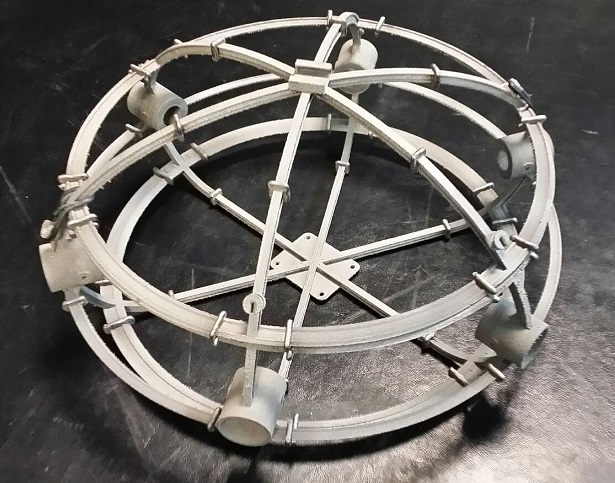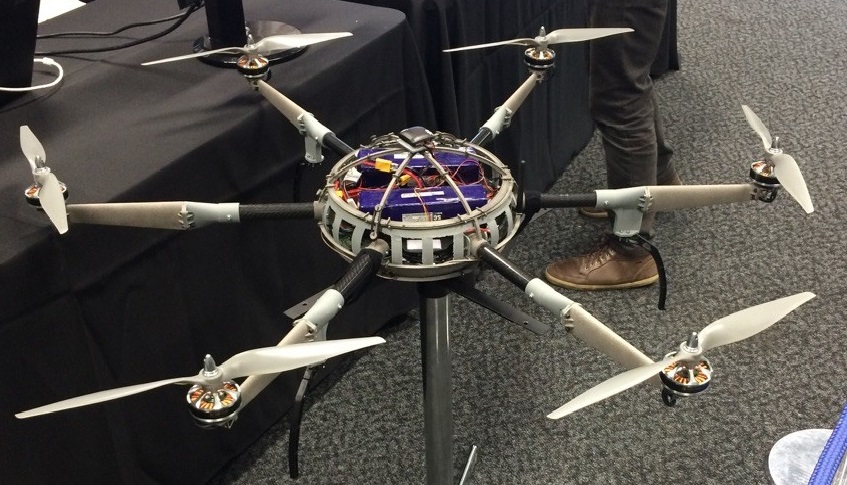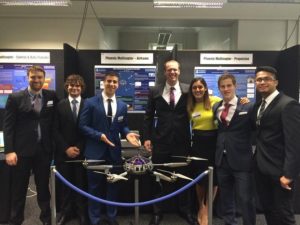A group of Melbourne University students have designed a 3D printed, titanium drone to fight bushfires.
A spherical drone with six arms and propellers sits on a stand at an exhibition
Made using 3D printing, this fire-fighting titanium drone is light, temperature resistant, and uses less battery, giving it a longer flight time.
Santa might find his sleigh overloaded with drones this Christmas, but if he was bringing a lucky boy or girl this ultra-light, aerodynamic titanium drone there would be no strain on those long suffering reindeer.
Drones or Unmanned Aerial Vehicles (UAVs) certainly have become more popular over the years. And we’re not talking about those terrible remote controlled helicopters you’d get at a petrol station that break in five minutes – we’re interested in remote controlled drones for commercial operations, like aerial imagery, package delivery, and even weed eradication. What about a drone to help fight bushfires?
The drones required for these serious tasks are quite complex and building one for a specific task, like fighting fires, can be costly.
Despite the fact there are many drone models available on the market a company would still need to spend around $60k for a custom UAV, then invest additional funds to modify it to meet specific industrial requirements. Many of these generic drones use the same limited battery that only allows for a flight time between 20 and 30 minutes. And with 90 per cent of drones made of a thin, less-than-robust carbon fibre construction, a pilot error can often result in serious and costly damage – not ideal for the types of environments a fire-fighting drone would need to survive.

The spherical body of the drone, made up of individual parts
The 3D printed titanium parts come together to make up the spherical body of the lightweight and durable drone.
These challenges inspired a team of bright young engineering students from Melbourne University to apply their newly acquired skills to make a better, lighter, longer-lasting drone. And not just for the purpose of bolting on a Go-Pro and scaring the neighbourhood pets, they created a UAV durable enough for the Victorian Metropolitan and Country Fire Brigades (MCFB). The brief was to design and build a unit that could hover in hot places and send clear thermal images back to ground in real time. They also needed something that could withstand crashes, and finally, a drone that could last a lot longer on a single charge.
The students thought that changing the aerodynamics of a UAV to reduce drag might result in less drain on the battery, and thereby increase flight time. They decided to use an aerodynamic airfoil shaped arms along with other custom designed aerodynamic parts.
These unique shapes certainly couldn’t be manufactured the traditional way using a material like carbon fibre that doesn’t lend itself to complicated geometry. So the students opted for titanium, with its attractive properties of strength, lightness and temperature resistance.
And where better to get the expertise and equipment needed to mould titanium into complex shapes? Our Lab 22 in Clayton Victoria, of course.
With designs for individual UAV components in hand, the team headed off to speak with experimental scientist Daren Fraser about using 3D printing to build the new components. The team at Lab 22 helped the students optimise component design to make the most of the printing process, resulting in substantial manufacturing cost savings.
The airfoil shaped arms took one day to print, and the rest of the components were completed by the next day. They were then blasted with titanium alloy powder to remove any loose, plaque before they were ready to be integrated into the drone.
Seven university students stand behind the drone they designed, at an exhibition
Melbourne university students show off their 3D printed fire-fighting drone. L-R: Daniel Candy, Geoff Bullen, Mehmet Ata, Prithu Parker, Serina Gill, Kevin Dow and Afif Norzal.
The proof-of-concept design was a success, with the students demonstrating that manufacturing of industry specific drones can be kept inside Australia, using Australian technology and resources.
The six airfoil shaped arms reduced drag by 60 per cent, and as anticipated, the changed shape and lightweight titanium increased the battery life. It is expected the flight time will extend to 45 minutes, close to double that achieved with the old design! An added bonus is that any parts damaged during flights can easily be re-printed.
The five mechanical, and two mechatronic engineers went on to win an Autodesk CAD prize and a Wade Institute Entrepreneurship Prize for their efforts. Goes to show the value in taking engineering principals into account, and making the most of 3D printing.
Have you got a project that’s needs our expertise? Visit us here to learn more about our work in manufacturing.




Pingback: Stampato in 3D il primo drone ultra-leggero in titanio antincendio – STAMPA 3D STORE